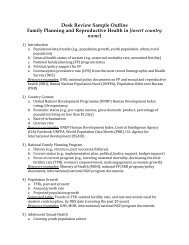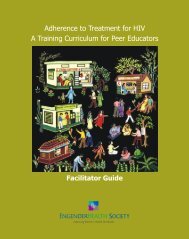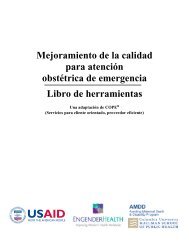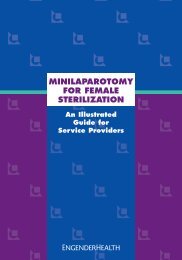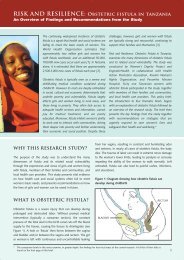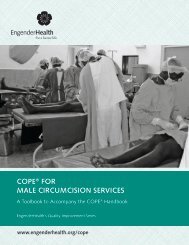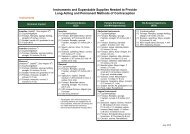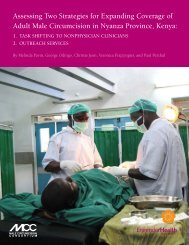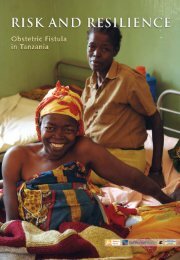Help-Seeking Pathways and Barriers for ... - EngenderHealth
Help-Seeking Pathways and Barriers for ... - EngenderHealth
Help-Seeking Pathways and Barriers for ... - EngenderHealth
Create successful ePaper yourself
Turn your PDF publications into a flip-book with our unique Google optimized e-Paper software.
<strong>and</strong> maternal <strong>and</strong> child health (well baby) visits [Example of USAID <strong>and</strong> IGWG<br />
guidance on best practices <strong>for</strong> these integration approaches 35 ];<br />
c. Ensure the availability of psychosocial care <strong>for</strong> survivors. This recommendation<br />
could be pursued as part of the “one-stop” model, or through a well-coordinated<br />
referral network.<br />
D. Develop a Well-Coordinated Referral System to Respond to Survivors’<br />
Needs<br />
In addition to improving the quality of care available to survivors of GBV, the establishment<br />
of a well-coordinated system of referrals <strong>for</strong> survivors is critical. An efficient referral system<br />
will improve both the quality <strong>and</strong> timeliness of care <strong>and</strong> support that survivors are able to<br />
receive through <strong>for</strong>mal pathways. Together with community awareness raising campaigns, a<br />
referral system that is structured around survivors’ needs is expected to enhance the care<br />
<strong>and</strong> support that survivors receive through in<strong>for</strong>mal channels.<br />
1. Establishing a strong referral system<br />
a. Organize joint opportunities <strong>for</strong> training of key stakeholders, including traditional<br />
structures, local government authorities, <strong>and</strong> civil society;<br />
b. Create inter-sectoral mechanisms <strong>for</strong> the development of a strategy to establish<br />
<strong>and</strong> manage a referral system <strong>and</strong> to apply the existing GBV-related laws at the<br />
local, ward, <strong>and</strong> district levels;<br />
c. Explore options <strong>for</strong> strengthening the capacity of existing duty bearers (<strong>for</strong><br />
example, Social Welfare Officers <strong>and</strong> Community Development Officers) to take<br />
on the role of coordinating <strong>and</strong> monitoring services among providers in their<br />
districts;<br />
d. Seek <strong>and</strong> foster partnerships between existing organizations <strong>and</strong> service<br />
providers working on GBV (<strong>and</strong> other <strong>for</strong>ms of violence, including violence<br />
against children), <strong>and</strong> strengthen coordination across these groups to ensure a<br />
tighter network of services <strong>and</strong> care.<br />
For the final two referral recommendations, the research team notes that in many districts,<br />
the Social Protection Officer is already the focal point <strong>for</strong> coordinating the various actors <strong>and</strong><br />
agencies engaged in the child protection system. As the MoHSW continues to roll out this<br />
model to other districts, one option <strong>for</strong> maximizing coordination <strong>and</strong> efficiency would be to<br />
integrate protection from <strong>and</strong> response to GBV into this existing service delivery<br />
mechanism.<br />
35 http://www.igwg.org/Publications/GenderHIVSelectedResourcs.aspx<br />
<strong>Help</strong>-<strong>Seeking</strong> <strong>Pathways</strong> <strong>and</strong> <strong>Barriers</strong> <strong>for</strong> Survivors of GBV in Tanzania March 2013<br />
Page 58




